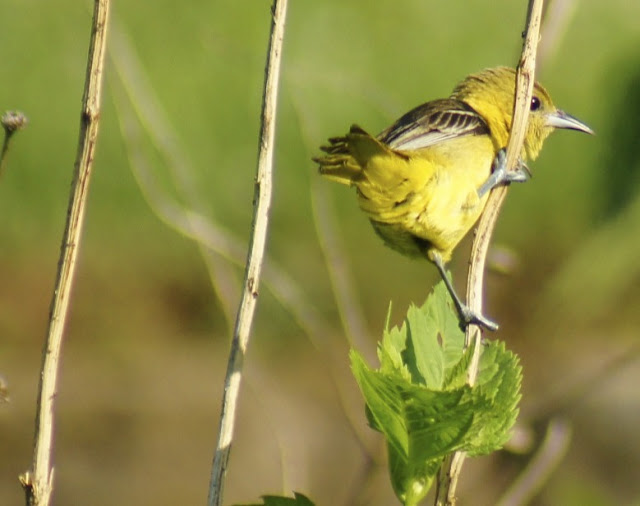They're even more common in Pennsylvania, and here in the West Chester area they are much more brazen, much more conspicuous. Of course, they're Warblers, and Warblers seldom take it easy on photographers. But the opportunities are better and more numerous here. Finally I came away with a decent shot of a Yellow Warbler.
The difference between Arizona and Pennsylvania Yellowthroats is especially noticeable. The Common Yellowthroats in Arizona live in the thick reeds along water features and seldom come out in the open. Although not in huge numbers, they do breed and nest in the state. I have never seen them really displaying, singing, or socializing. It's all shadows and secrecy in AZ.
In Pennsylvania, I checked out Stroud Preserve, Ridley Creek State Park, and Exton Park, three great preserves in the West Chester area. At every single one of these sites, I've been privileged to see Yellowthroats perched and singing up in the trees, foraging out in the open and moving with much more publicity than in Arizona. My photos are still a bit hampered by the continually overcast weather, but I do appreciate the lower temperatures.
I really like Common Yellowthroats. They look like Tweety Bird from those old Loony Tunes combined with Zorro.
The Warblers aren't the only yellow birds I've been enjoying lately. This spring has already afforded me great looks at Bullock's and Hooded Orioles in Arizona, and now I've had a chance to see the eastern varieties too.
The male Baltimore Oriole is a beautiful thing. Given the haziness in this shot, you may just have to take my word for it. Hopefully, you've seen a few of your own!

The Orchard Oriole is the comparably drab cousin of the Baltimore Oriole. Their orange is a more unique, rusty coloration, but this sets them apart and, for my money, makes them one of the most interesting and beautiful Orioles in the group. Unfortunately I have not seen any mature males. A first-year, along with this lovely female, have sufficed.
Like Marsh Wrens, Yellowthroats, Song Sparrows, and other birds that prefer tall grasses and reeds, the Orchard Oriole is pretty flexible.
*Update: The morning I scheduled this to post, I saw a male Orchard Oriole too. Although this male, like the Baltimore, makes this post less yellow, it seems appropriate to include him here too:
Birding in southeast Pennsylvania is mellow, and there is plenty of yellow. Both of these characteristics suit me just fine!






